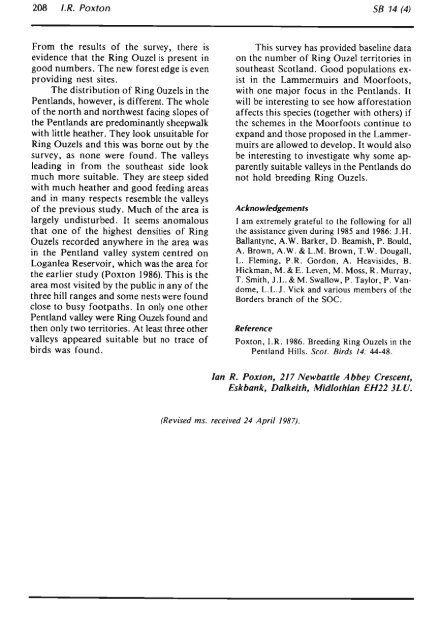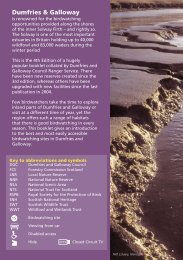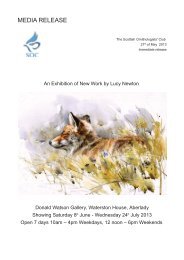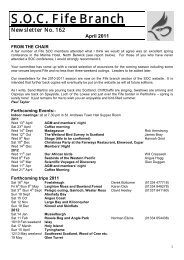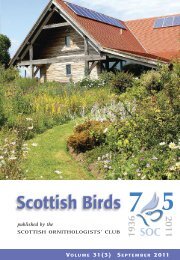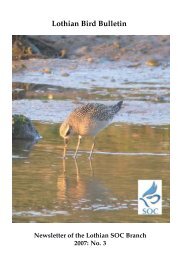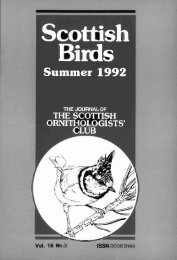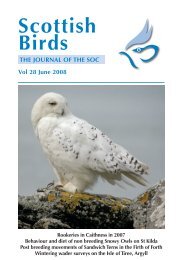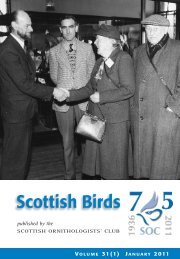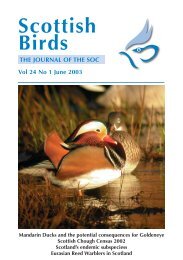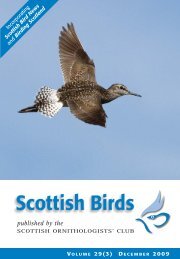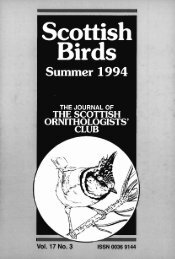V 14 No.4 - The Scottish Ornithologists' Club
V 14 No.4 - The Scottish Ornithologists' Club
V 14 No.4 - The Scottish Ornithologists' Club
Create successful ePaper yourself
Turn your PDF publications into a flip-book with our unique Google optimized e-Paper software.
208 I.R. Poxton<br />
58 <strong>14</strong> (4)<br />
From the results of the survey, there is<br />
evidence that the Ring Ouzel is present in<br />
good numbers. <strong>The</strong> new forest edge is even<br />
providing nest sites.<br />
<strong>The</strong> distribution of Ring Ouzels in the<br />
Pentlands, however, is different. <strong>The</strong> whole<br />
of the north and northwest facing slopes of<br />
the Pentlands are predominantly sheepwalk<br />
with little heather. <strong>The</strong>y look unsuitable for<br />
Ring Ouzels and this was borne out by the<br />
survey, as none were found. <strong>The</strong> valleys<br />
leading in from the southeast side look<br />
much more suitable. <strong>The</strong>y are steep sided<br />
with much heather and good feeding areas<br />
and in many respects resemble the valleys<br />
of the previous study. Much of the area is<br />
largely undisturbed. It seems anomalous<br />
that one of the highest densities of Ring<br />
Ouzels recorded anywhere in the area was<br />
in the Pentland valley system centred on<br />
Loganlea Reservoir, which was the area for<br />
the earlier study (Poxton 1986). This is the<br />
area most visited by the public in any of the<br />
three hill ranges and some nests were found<br />
close to busy footpaths. In only one other<br />
Pentland valley were Ring Ouzels found and<br />
then only two territories. At least three other<br />
valleys appeared suitable but no trace of<br />
birds was found.<br />
This survey has provided baseline data<br />
on the number of Ring Ouzel territories in<br />
southeast Scotland. Good populations exist<br />
in the Lammermuirs and Moorfoots,<br />
with one major focus in the Pentlands. It<br />
will be interesting to see how afforestation<br />
affects this species (together with others) if<br />
the schemes in the Moorfoots continue to<br />
expand and those proposed in the Lammermuirs<br />
are allowed to develop. It would also<br />
be interesting to investigate why some apparently<br />
suitable valleys in the Pentlands do<br />
not hold breeding Ring Ouzels.<br />
Acknowledgements<br />
I am extremely grateful to the following for all<br />
the assistance given during 1985 and 1986: J.H .<br />
Ballantyne, A.W. Barker, D. Bearnish, P. Bould,<br />
A. Brown, A.W. & L.M. Brown, T.W. Dougall,<br />
L. Fleming, P.R. Gordon, A. Heavisides, B.<br />
Hickman, M. & E. Leven, M. Moss, R. Murray,<br />
T. Smith, J.L. & M. Swallow, P. Taylor, P . Vandome,<br />
L.L.J. Vick and various members of the<br />
Borders branch of the SOC.<br />
Reference<br />
Poxton, I.R. 1986. Breeding Ring Ouzels in the<br />
Pentland Hills. Scot. Birds <strong>14</strong>: 44-48.<br />
Ian R. Poxton, 217 NewbaUle Abbey Crescent,<br />
Eskbank, Dalkeith, Midlothian EH223LU.<br />
(Revised ms. received 24 April 1987).


